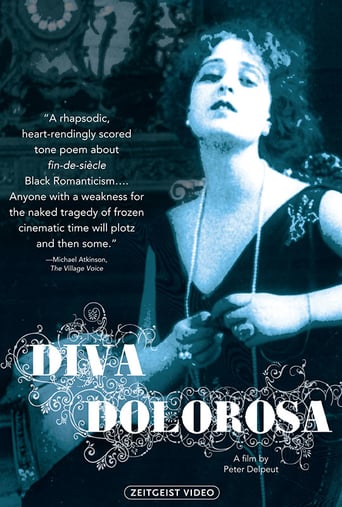

A heart-breaking film of incredible beauty! I was guided towards this film by Delpeut's other "found footage" masterpiece, Lyrical Nitrate. In that assemblage I was introduced to the genius of Lyda Borelli and sought out whatever titles of hers may still exist -this was the top of the list.Anyone who has any sort of preconceived notions about silent film which involves goofy black-and-white makeup, cardboard sets, static camera setups and custard pies is in for a surprise. Anyone who thinks that silent film acting was all about waving your arms and stalking back and forth is in for an earth-shattering revelation.True, there is a bit of monochromatic makeup (panchromatic hadn't yet been perfected), but the use is masterly and you are more readily reminded of today's "heroin chic" or Goth makeup fashion. In most instances the "back to the future" quality of the makeup actually works in its favor.The sets glimpsed here are anything but cardboard. The entire collection of films appear to have been shot on location, in actual mansions or else on lavishly appointed sets that would rival anything DeMille or Merchant/Ivory could devise.The direction and cinematography of the original films is quite frankly breath-taking. There was a scene in an opera house early on in which the director executed a camera move (panning the breadth of the opera house from inside one of the boxes using the actress as the pivot point) which I had never seen done in a film before. It was startling. Elsewhere there are scenes of ravishing beauty, artistic composition simply for art's sake and camera work designed simply to showcase the beauty or the expression of the actress or her movements.Just look at the image on the box cover and you can instantly sense that our heroine is in the midst of some torment within herself. So much from just a still frame -and even there it is so carefully composed an image that it becomes art in itself. The entire film is that rare and perfect blending of art and drama so delicately balanced that one never compromises the other. Scenes are played for the maximum dramatic impact (and there are some category 10 hurricanes brewing), but at the same same time the images are composed so as to resemble Beardsley illustrations or Old Masters paintings. But again, one never outweighs or interferes with the other.First and foremost, each actress in the several clips assembled is given license to unleash her dramatic demons and take no prisoners. This they do with all the fury or a woman scorned (Do not expect hand-wringing melodrama, or anything along the lines of a Lifetime Movie for Women, these women are Divas of the highest order, sexually liberated and may the gods help anyone who gets in their way).Secondly the actresses are treated by their directors and cinematographers as goddesses incarnate, and are so presented in all their silver nitrate glory; faces in sublime agony become poetic landscapes of beauty, or a coquettish glance is transformed into a thunderstorm about to explode. Images of ravishing beauty accompany scenes of soul-wrenching misery. The mixture is astounding.Forget any thoughts of banana peels or custard pie fights; there is not a single instant of slapstick comedy anywhere on screen. Quite the opposite, this film is drenched with seriousness to the point of suicide. Had there been sound these characters would be singing grand opera. The women whose lives are enacted in these all-too-brief moments were fraught with sinful passions, sorrow, anguish and -of course- high drama.It is this last which I mean in in its best sense, not in the current flippant meaning. This is drama of the most operatic proportions; of Ophelia decking herself in silk and veils to take her last, final swim. This is of the woman, so desperate in love despite her illness (one is reminded of La Boheme and her TB) that she willingly lets herself be overdosed on morphine so she can share one moment of love. There are Salome's and Lady MacBeth's here as well -all wrenching and grasping, seething and smoldering visibly as well as below the surface.But again, don't expect "silent movie" acting. These women, Lyda Borelli, Pina Menichelli and the others -grand dames every one- threw themselves bodily into their roles (quite literally at times) but never at any point do their agonies come across as comedic or unbelievable. Names like Streep, Close and Sarandon spring to mind immediately when watching the performances; these are women who can act with their faces, their eyes, with the simple turn of the head.It has taken nearly a hundred years for the supreme artistry of the Dolorous Diva to come full circle and be appreciated. What a loss that so much of the output of these superstars of early film has been lost. Delpeut's film has restored at least part of them to their rightful niche of immortal performances.Diva Dolorosa is a spectacular achievement on so many levels
... View More